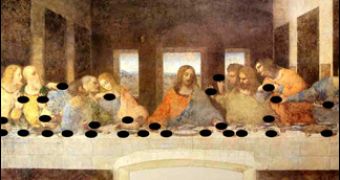The real Da Vinci code has been found, but this time it comes with a different view than the one we know from Dan Brown's book or some Hollywood movies. Giovanni Maria Pala, 45, an Italian musician and computer technician from Lecce (southern Italy) has uncovered (at least he says so) musical notes encoded in the famous Da Vinci's "Last Supper", which could possibly accompany the 15th century wall painting. "It sounds like a requiem. It's like a soundtrack that emphasizes the passion of Jesus.", said Pala.
The "Last Supper" scene was painted from 1494 to 1498 in Milan's Church of Santa Marie delle Grazie, representing the Biblical scene of Jesus' last meal with the 12 Apostles the night when he was arrested (and subsequently crucified), vividly displaying the shock of the followers while Jesus tells them abut his inherent betray by one of them.
Pala's interest in this painting started in 2003, when a news program credited scientists to have supposed that the Leonardo could have hidden a musical composition in it. Pala's newly released book, "La Musica Celata" ("The Hidden Music"), decodes the painting's elements having a symbolic value in Christian theology and being at the same time musical clues. The author first drew the five musical lines across the painting, delimited by the breads on the table while the hands of the characters of Jesus were musical notes by themselves. All this got musical sense only when read from right to left, as Leonardo used to write. "This fit the relation in Christian symbolism between the bread, representing the body of Christ, and the hands, which are used to bless the food," said Pala.
Other clues in the painting pointed to Pala the slow rhythm and each note's duration, completing a 40-second "hymn to God" that "sounds best on a pipe organ, the instrument most commonly used in Leonardo's time for spiritual music." The resulting Bach-like organ played piece is extremely slow but musical.
This "is plausible. Previous research has indicated the hands of the Apostles in the painting can be substituted with the notes of a Gregorian chant, though so far no one had tried to work in the bread loaves.", said Alessandro Vezzosi, a Leonardo expert and the director of a museum dedicated to the artist in his hometown of Vinci. "There's always a risk of seeing something that is not there, but it's certain that the spaces (in the painting) are divided harmonically. Where you have harmonic proportions, you can find music.", Vezzosi told the AP. "Though Leonardo was more noted for his paintings, sculptures and visionary inventions, he was also a musician.", Vezzosi also added.
Da Vinci, who played the lyre himself, invented several instruments, and wrote musical riddles, in his specific style, from right to left. Unlike "The Da Vinci Code", with its dark mystery of Jesus having a child with Maria Magdalena and hidden by the Catholic Church, this is much more benign. Leonardo "wasn't a heretic like some believe. What emerges is a man who believes, a man who really believes in God", Pala concluded.

 14 DAY TRIAL //
14 DAY TRIAL //